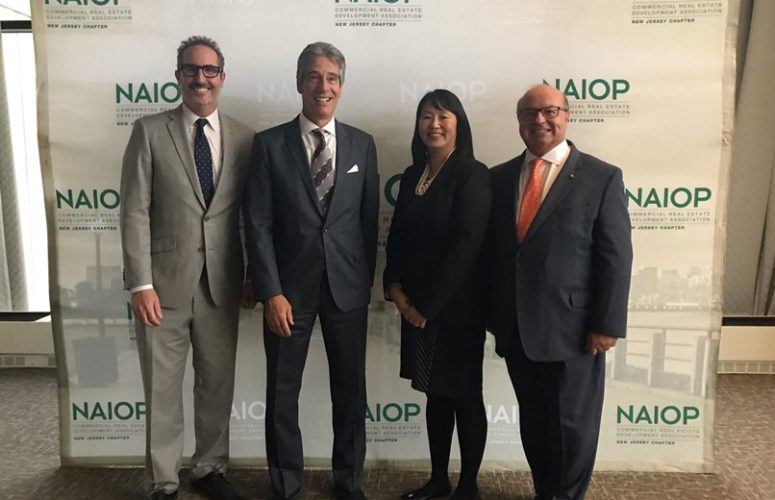
NAIOP Examines Impact of Autonomous Vehicles
On Nov 12, 2019NAIOP New Jersey recently brought together industry experts and state politicians to explore the development and introduction of fully autonomous vehicles and their impact on commercial real estate, the transportation industry and nationwide parking trends. Held at One Gateway Center in Newark, the interactive session, titled “The Future of Mobility: Autonomous Vehicles & Parking Trends,” explored how the arrival of autonomous cars and ride sharing services will reshape the urban landscape and enrich the human experience within the next 10 years.
Joe Brancato, a co-managing principal for Gensler’s Northeast and Latin America regions and vice chairman of the firm’s Board of Directors, detailed his organization’s vision for a society impacted by the collaboration of technology companies and auto manufacturers which is likely to make gas-powered combustible engines obsolete within the next 30 years.
“Car ownership is expected to peak in 2020, and by 2035 only five percent of the population will own a car,” explained Brancato. “Personal transportation will be operated primarily as a service and people who own cars will not only pay a lot for the rights of ownership, but be limited to where they can drive. This will all happen as driverless, autonomous vehicles displace our current modes of transportation and ride sharing becomes the norm.”
A Significant Transformation that Will Improve Living Experiences
According to Brancato, this significant transformation will not only provide improved living experiences for Americans nationwide, but will also affect the future of urban design, while positively impacting the over-burdened real estate markets experienced by many urban cities. In Gensler’s scenario, the more than three billion parking spots found globally will be transformed to bike lanes, dining areas, parks and other meeting places as cities “give the streets back to the people.”
The unprecedented dedication to mobility will be accompanied by the increased ability of autonomous vehicles to communicate with one another and make better sense of the environment via the cloud. As a result, the accidents that claim the lives of nearly 40,000 Americans a year will be greatly reduced as vehicles automatically track speeds and adjust for obstacles and traffic in real time.
“We’re talking about the gain of immense efficiencies,” said Brancato. “Individuals freed from the physical need to drive will have more time to do the things typically reserved for bus and train riders.”
After citing several examples that included the Brooklyn Queens Crossing (BQXL) project and the leveraging of 15 miles of freight lines to produce additional community and office space, Brancato highlighted the impact driverless vehicles and ride sharing will have on the CRE marketplace and construction of future infrastructure, architecture and buildings. These include:
- Availability of prime real estate and more than 125,000 gas stations throughout the U.S. This includes transitioning these prime lots into fitness oases, where users can do far more than recharge or even exchange electric batteries.
- Repurposing not-so prime real estate spots such as car dealerships, car washes and repair shops into areas that better meet community needs.
- Driverless commercial shipments that will utilize electric vehicles that can travel approximately 600 miles on a single charge.
- Adaptive use of topologies that will reduce parking footprints nationwide by 25 to 100 percent depending on the city and community. Gensler envisions the stacking of autonomous vehicles three inches apart to greatly reduce parking requirements and create space for other uses
- Greenspace and the reallocation of existing low-grade parking structures into community assets such as linear parks, modular housing for the homeless, mixed-use office and residential complexes, and drop-off and pick-up zones designed to facilitate last-mile delivery.
But Brancato also warned that the race to adoption will be met with major challenges. “Legislation across every state, city and federal level will have to be modified to enable uniform adoption and validate the emergence of driverless cars,” he said. Other issues include cyber security and the hacking of smart systems; the downsizing of the car insurance industry, which generates about $200 billion annually in the U.S.; lost income from the issuance of tickets for parking and other traffic violations; and safety concerns related to potholes, weather, construction and other obstacles.
Brancato concluded, “It’s imperative to focus not only on current needs and uses, but the impact and repurposing of the projects that won’t be completed for another eight to 10 years. Everyone from architects and designers to manufacturers, software engineers and city planners will play a significant role in this future and the betterment of the human experience.”
Local Urban Planning Trends and Parking Challenges
Insights into the acceptance of future autonomous vehicle parking trends, proper planning tools, financing and adaptive use of existing spaces were just a few of the issues explored with Allison Ladd, Newark’s deputy mayor and director of economic and housing development, and Red Bank Mayor Pasquale Menna. Moderated by CBRE executive vice president Jeremey Neuer, the Q&A was designed to present a real-world treatise on the future of urban planning and its impact on local real estate, the economy and safety in two of the state’s most diverse cities.
As a former deputy director and chief of staff of the Department of Housing and Community Development in Washington, D.C., Ladd related how her two decades of urban planning and economic development experience translated into the local Newark marketplace. “Scooters are the rage in D.C.,” offered Ladd. “It’s a primary mode of transportation, but no one saw it coming. So, it just shows that you have to think ahead.”
“Newark’s infrastructure is different from the D.C. market. You need a vehicle here, especially in the winter. That’s why we’re developing a five-year plan that matches the future with the present. This includes plans for the parking spots we may not need a few years from now. These efforts involve talking with developers about the conversion of existing parking into office or residential space, while providing an affordable alternative to Jersey City and New York City.”
For Menna, responsible sustainable development has been a goal for the past 32 years – first as a city councilman for 18 years and then as Red Bank’s mayor since 2006. “Red Bank has had parking problems since the horse and buggy days. We now have 3,000 parking spaces, but we’re definitely seeing a shift toward meeting current needs with the transitioning of these spots to different uses when usage is low.”
Menna noted this includes turning parking decks into economic machines that can provide extra space for festivals and other community events. “Our focus is always on finding the best ways to bring new life into the community.”
To access more business news, visit NJB News Now.
Related Articles:





